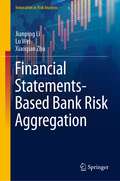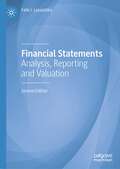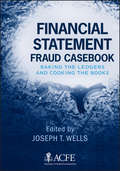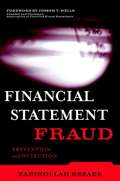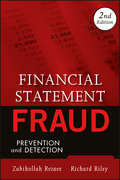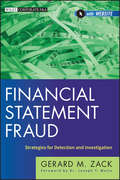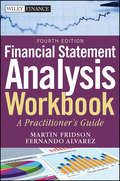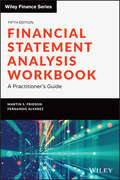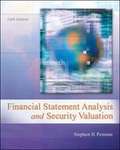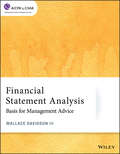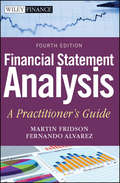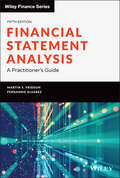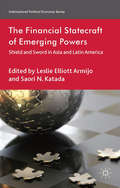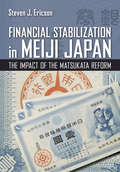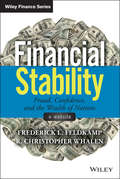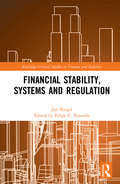- Table View
- List View
Financial Statements-Based Bank Risk Aggregation (Innovation in Risk Analysis)
by Jianping Li Lu Wei Xiaoqian ZhuThis book proposes a bank risk aggregation framework based on financial statements. Specifically, bank risk aggregation is of great importance to maintain stable operation of banking industry and prevent financial crisis. A major obstacle to bank risk management is the problem of data shortage, which makes many quantitative risk aggregation approaches typically fail. Recently, to overcome the problem of inaccurate total risk results caused by the shortage of risk data, some researchers have proposed a series of financial statements-based bank risk aggregation approaches. However, the existing studies have drawbacks of low frequency and time lag of financial statements data and usually ignore off-balance sheet business risk in bank risk aggregation. Thus, by reviewing the research progress in bank risk aggregation based on financial statements and improving the drawbacks of existing methods, this book proposes a bank risk aggregation framework based on financial statements. It makes full use of information recorded in financial statements, including income statement, on- and off-balance sheet assets, and textual risk disclosures, which solves the problem of data shortage in bank risk aggregation to some extent and improves the reliability and rationality of bank risk aggregation results. This book not only improves the theoretical studies of bank risk aggregation, but also provides an important support for the capital allocation of the banking industry in practice. Thus, this book has theoretical and practical importance for bank managers and researchers of bank risk management.
Financial Statements: Analysis and Reporting
by Felix I. LessamboThrough a mixture of concepts and examples, this book demystifies the variety of elements of financial accounting and uncovers the need-to-know information for certification in this field. This book covers the two aspects of financial statement analysis, namely quantitative and non-quantitative analysis. Concluding with helpful case studies, the book will appeal to students and academics of financial accounting.
Financial Statements: Analysis, Reporting and Valuation
by Felix I. LessamboThrough a mixture of concepts and examples, the second edition of this book demystifies the variety of elements of financial accounting and uncovers the need-to-know information for certification in this field. This book covers the two aspects of financial statement analysis, namely quantitative and non-quantitative analysis. Unique to the second edition, the book will also cover Non-GAA- metrics and valuation accounting. Concluding with helpful and updated case studies, the book will appeal to students and academics of financial accounting.
Financial Statement Fraud Casebook: Baking the Ledgers and Cooking the Books
by Joseph T. WellsA comprehensive look at financial statement fraud from the experts who actually investigated them This collection of revealing case studies sheds clear insights into the dark corners of financial statement fraud. Includes cases submitted by fraud examiners across industries and throughout the world Fascinating cases hand-picked and edited by Joseph T. Wells, the founder and Chairman of the world's leading anti-fraud organization ? the Association of Certified Fraud Examiners (ACFE) ? and author of Corporate Fraud Handbook Outlines how each fraud was engineered, how it was investigated and how the perpetrators were brought to justice Providing an insider's look at fraud, Financial Statement Fraud Casebook illuminates the combination of timing, teamwork and vision necessary to understand financial statement fraud and prevent it from happening in the first place.
Financial Statement Fraud Casebook: Baking the Ledgers and Cooking the Books
by Joseph T. WellsA comprehensive look at financial statement fraud from the experts who actually investigated them This collection of revealing case studies sheds clear insights into the dark corners of financial statement fraud. Includes cases submitted by fraud examiners across industries and throughout the world Fascinating cases hand-picked and edited by Joseph T. Wells, the founder and Chairman of the world's leading anti-fraud organization ? the Association of Certified Fraud Examiners (ACFE) ? and author of Corporate Fraud Handbook Outlines how each fraud was engineered, how it was investigated and how the perpetrators were brought to justice Providing an insider's look at fraud, Financial Statement Fraud Casebook illuminates the combination of timing, teamwork and vision necessary to understand financial statement fraud and prevent it from happening in the first place.
Financial Statement Fraud: Prevention and Detection
by Zabihollah RezaeeHigh profile cases of financial statement fraud have been dominating the news recently, causing people to question the accuracy of the financial information made available by companies. This book covers the roles and responsibilities associated with preventing and detecting financial statement fraud, including current developments and professional activities intended to reduce the occurrences of fraudulent financial reporting. It discusses the failures involved in the Enron collapse and includes a Forward by Joseph T. Wells from the Association of Certified Fraud Examiners. This books provides an invaluable context for understanding financial statement fraud.
Financial Statement Fraud: Prevention and Detection
by Zabihollah Rezaee Richard RileyPractical examples, sample reports, best practices and recommendations to help you deter, detect, and prevent financial statement fraud Financial statement fraud (FSF) continues to be a major challenge for organizations worldwide. Financial Statement Fraud: Prevention and Detection, Second Edition is a superior reference providing you with an up-to-date understanding of financial statement fraud, including its deterrence, prevention, and early detection. You will find A clear description of roles and responsibilities of all those involved in corporate governance and the financial reporting process to improve the quality, reliability and transparency of financial information. Sample reports, examples, and documents that promote a real-world understanding of incentives, opportunities, and rationalizations Emerging corporate governance reforms in the post-SOX era, including provisions of the SOX Act, global regulations and best practices, ethical considerations, and corporate governance principles Practical examples and real-world "how did this happen" discussions that provide valuable insight for corporate directors and executives, auditors, managers, supervisory personnel and other professionals saddled with anti-fraud responsibilities Expert advice from the author of Corporate Governance and Ethics and coauthor of the forthcoming Wiley textbook, White Collar Crime, Fraud Examination and Financial Forensics Financial Statement Fraud, Second Edition contains recommendations from the SEC Advisory Committee to reduce the complexity of the financial reporting process and improving the quality of financial reports.
Financial Statement Fraud: Prevention and Detection
by Zabihollah Rezaee Richard RileyPractical examples, sample reports, best practices and recommendations to help you deter, detect, and prevent financial statement fraud Financial statement fraud (FSF) continues to be a major challenge for organizations worldwide. Financial Statement Fraud: Prevention and Detection, Second Edition is a superior reference providing you with an up-to-date understanding of financial statement fraud, including its deterrence, prevention, and early detection. You will find A clear description of roles and responsibilities of all those involved in corporate governance and the financial reporting process to improve the quality, reliability and transparency of financial information. Sample reports, examples, and documents that promote a real-world understanding of incentives, opportunities, and rationalizations Emerging corporate governance reforms in the post-SOX era, including provisions of the SOX Act, global regulations and best practices, ethical considerations, and corporate governance principles Practical examples and real-world "how did this happen" discussions that provide valuable insight for corporate directors and executives, auditors, managers, supervisory personnel and other professionals saddled with anti-fraud responsibilities Expert advice from the author of Corporate Governance and Ethics and coauthor of the forthcoming Wiley textbook, White Collar Crime, Fraud Examination and Financial Forensics Financial Statement Fraud, Second Edition contains recommendations from the SEC Advisory Committee to reduce the complexity of the financial reporting process and improving the quality of financial reports.
Financial Statement Fraud: Strategies for Detection and Investigation (Wiley Corporate F&A #632)
by Gerard M. ZackValuable guidance for staying one step ahead of financial statement fraud Financial statement fraud is one of the most costly types of fraud and can have a direct financial impact on businesses and individuals, as well as harm investor confidence in the markets. While publications exist on financial statement fraud and roles and responsibilities within companies, there is a need for a practical guide on the different schemes that are used and detection guidance for these schemes. Financial Statement Fraud: Strategies for Detection and Investigation fills that need. Describes every major and emerging type of financial statement fraud, using real-life cases to illustrate the schemes Explains the underlying accounting principles, citing both U.S. GAAP and IFRS that are violated when fraud is perpetrated Provides numerous ratios, red flags, and other techniques useful in detecting financial statement fraud schemes Accompanying website provides full-text copies of documents filed in connection with the cases that are cited as examples in the book, allowing the reader to explore details of each case further Straightforward and insightful, Financial Statement Fraud provides comprehensive coverage on the different ways financial statement fraud is perpetrated, including those that capitalize on the most recent accounting standards developments, such as fair value issues.
Financial Statement Fraud: Strategies for Detection and Investigation (Wiley Corporate F&A)
by Gerard M. ZackValuable guidance for staying one step ahead of financial statement fraud Financial statement fraud is one of the most costly types of fraud and can have a direct financial impact on businesses and individuals, as well as harm investor confidence in the markets. While publications exist on financial statement fraud and roles and responsibilities within companies, there is a need for a practical guide on the different schemes that are used and detection guidance for these schemes. Financial Statement Fraud: Strategies for Detection and Investigation fills that need. Describes every major and emerging type of financial statement fraud, using real-life cases to illustrate the schemes Explains the underlying accounting principles, citing both U.S. GAAP and IFRS that are violated when fraud is perpetrated Provides numerous ratios, red flags, and other techniques useful in detecting financial statement fraud schemes Accompanying website provides full-text copies of documents filed in connection with the cases that are cited as examples in the book, allowing the reader to explore details of each case further Straightforward and insightful, Financial Statement Fraud provides comprehensive coverage on the different ways financial statement fraud is perpetrated, including those that capitalize on the most recent accounting standards developments, such as fair value issues.
Financial Statement Analysis Workbook: A Practitioner's Guide (Wiley Finance #599)
by Martin S. Fridson Fernando AlvarezAll too often, financial statements conceal more than they reveal. Even after the recent economic crisis, those analyzing financial statements face serious new concerns and challenges. The Fourth Edition of Financial Statement Analysis skillfully puts this discipline in perspective, and now, with this companion Workbook, you can hone your skills and test the knowledge you've gained from the actual text, before putting them to work in real-world situations. Question-and-answer sections within this Workbook correspond to each chapter of Financial Statement Analysis, Fourth Edition. Part One (Questions) provides chapter-by-chapter fill-in-the-blank questions, as well as financial statement and computational exercises. They are designed to be thought-provoking and require analysis and synthesis of the concepts covered in the book. The answers to all questions, which can be found in Part Two, are provided in boldfaced italic type in order to facilitate the checking of answers and comprehension of material. By enhancing your understanding of financial statement analysis, you can begin to undertake genuine, goal-oriented analysis and prepare for the practical challenges of contemporary business. This reliable resource will help you achieve such a difficult goal and allow you to make more informed decisions—whether you're evaluating a company's stock price or determining valuations for a merger or acquisition.
Financial Statement Analysis Workbook: A Practitioner's Guide (Wiley Finance #599)
by Martin S. Fridson Fernando AlvarezAll too often, financial statements conceal more than they reveal. Even after the recent economic crisis, those analyzing financial statements face serious new concerns and challenges. The Fourth Edition of Financial Statement Analysis skillfully puts this discipline in perspective, and now, with this companion Workbook, you can hone your skills and test the knowledge you've gained from the actual text, before putting them to work in real-world situations. Question-and-answer sections within this Workbook correspond to each chapter of Financial Statement Analysis, Fourth Edition. Part One (Questions) provides chapter-by-chapter fill-in-the-blank questions, as well as financial statement and computational exercises. They are designed to be thought-provoking and require analysis and synthesis of the concepts covered in the book. The answers to all questions, which can be found in Part Two, are provided in boldfaced italic type in order to facilitate the checking of answers and comprehension of material. By enhancing your understanding of financial statement analysis, you can begin to undertake genuine, goal-oriented analysis and prepare for the practical challenges of contemporary business. This reliable resource will help you achieve such a difficult goal and allow you to make more informed decisions—whether you're evaluating a company's stock price or determining valuations for a merger or acquisition.
Financial Statement Analysis Workbook: A Practitioner's Guide (Wiley Finance)
by Martin S. Fridson Fernando AlvarezThe helpful workbook to help practice assessing financial statements Financial statement analysis is essential as part of any well-organized financial portfolio. As a companion piece, Financial Statement Analysis Workbook: A Practitioner's Guide allows readers the opportunity to test and hone the skills put forward in Martin Fridson and Fernando Alvarez's Financial Statement Analysis, a resource devoted to providing the analytical framework necessary to make sense of the sometimes misleading numbers put forth by companies. Scrutinizing financial statements allows one to, for example, evaluate a company&’s stock price or determine merger or acquisition valuations. The Financial Statement Analysis Workbook, then, provides a pathway to become familiar with these methodologies in order to be prepared to use them in real-world scenarios. With the skills provided within, you can begin to undertake goal-oriented preparation for the practical challenges of contemporary business, and feel confident in your financial decision-making. This is aided by: Question-and-answer sections within this Workbook correspond to each chapter of Financial Statement Analysis Financial statement and computational exercises designed to require analysis and synthesis of concepts covered in the core text A full list of answers in the second half of the book that help explain pitfalls within the questions An essential tool for professional analysts, investors, and students, Financial Statement Analysis Workbook offers the perfect opportunity to help turn theory into reality.
Financial Statement Analysis Workbook: A Practitioner's Guide (Wiley Finance #79)
by Martin S. Fridson Fernando AlvarezThe helpful workbook to help practice assessing financial statements Financial statement analysis is essential as part of any well-organized financial portfolio. As a companion piece, Financial Statement Analysis Workbook: A Practitioner's Guide allows readers the opportunity to test and hone the skills put forward in Martin Fridson and Fernando Alvarez's Financial Statement Analysis, a resource devoted to providing the analytical framework necessary to make sense of the sometimes misleading numbers put forth by companies. Scrutinizing financial statements allows one to, for example, evaluate a company&’s stock price or determine merger or acquisition valuations. The Financial Statement Analysis Workbook, then, provides a pathway to become familiar with these methodologies in order to be prepared to use them in real-world scenarios. With the skills provided within, you can begin to undertake goal-oriented preparation for the practical challenges of contemporary business, and feel confident in your financial decision-making. This is aided by: Question-and-answer sections within this Workbook correspond to each chapter of Financial Statement Analysis Financial statement and computational exercises designed to require analysis and synthesis of concepts covered in the core text A full list of answers in the second half of the book that help explain pitfalls within the questions An essential tool for professional analysts, investors, and students, Financial Statement Analysis Workbook offers the perfect opportunity to help turn theory into reality.
Financial Statement Analysis And Security Valuation (PDF)
by Stephen H. PenmanValuation is at the heart of investing. A considerable part of the information for valuation is in the financial statements. Financial Statement Analysis and Security Valuation, 5 e by Stephen Penman shows students how to extract information from financial statements and use that data to value firms. The 5th edition shows how to handle the accounting in financial statements and use the financial statements as a lens to view a business and assess the value it generates.
Financial Statement Analysis: Basis for Management Advice (AICPA)
by Wallace Davidson IIIThis book presents financial statements as a set of dynamic instruments that can be used for accurate, relevant, and timely financial decisions. It focuses on the economic and financial conditions that cause statements to change and discover how businesses can manage liquidity, debt, and profitability. Plus, explore effect ratios, causal ratios, pro forma analysis, sustainable growth, and much more. Key topics covered include: valuation techniques, effect ratios, DuPont system for analyzing profitability, causal analysis. how to conduct a financial statement analysis, users of financial statements, forecasting sustainable growth, and bankruptcy prediction models.
Financial Statement Analysis: Basis for Management Advice (AICPA)
by Wallace Davidson IIIThis book presents financial statements as a set of dynamic instruments that can be used for accurate, relevant, and timely financial decisions. It focuses on the economic and financial conditions that cause statements to change and discover how businesses can manage liquidity, debt, and profitability. Plus, explore effect ratios, causal ratios, pro forma analysis, sustainable growth, and much more. Key topics covered include: valuation techniques, effect ratios, DuPont system for analyzing profitability, causal analysis. how to conduct a financial statement analysis, users of financial statements, forecasting sustainable growth, and bankruptcy prediction models.
Financial Statement Analysis: A Practitioner's Guide (Wiley Finance #597)
by Martin S. Fridson Fernando AlvarezPraise for Financial Statement Analysis FOURTH EDITION "I love this book. It helps to develop the questioning mind—the mind of a financial detective. It teaches the art of skepticism and critical thinking. Readers go beyond definition and calculation and learn interpretation." —Philip L. Cooley, PhD, Prassel Distinguished Professor of Business, Trinity University "Over my decades of involvement with high-yield bonds, Marty Fridson has been the leading speaker of truth. As he so accurately states in Financial Statement Analysis, the credit investor is required to engage in a game of cat-and-mouse with company management's intent on minimizing their cost of capital by putting a positive gloss on their financial statements. The Fourth Edition of Marty's terrific book is the bible on how to detect and deal with these efforts." —Howard Marks, Chairman, Oaktree Capital Management "Financial Statement Analysis is a unique text; it combines great academic work with numerous real-life examples to form a highly useful reference for equity investors, debt holders, and investors who straddle both asset classes. Whether you are an investor, an investment advisor, or a teacher, Financial Statement Analysis will prove very valuable." —Margaret M. Cannella, former head of Global Credit Research, J.P. Morgan and Adjunct Professor, Columbia Business School "Marty has seen it all! He has had a front-row seat to see the birth, death, and rebirth of the high-yield bond market . . . several times over! In the Fourth Edition of Financial Statement Analysis, Marty clearly demonstrates that despite the enactment of Sarbanes-Oxley in 2002, and other attempts to curtail abuse of the system, one needs a critical analytical eye to be certain that management is not trying to obfuscate the truth. The case studies provide excellent and timely examples of some of the techniques that companies have used to mislead investors." —Edward Z. Emmer, former global head of Corporate and Government Ratings and Equity Research, Standard & Poor's "Those who read financial statements without understanding the strategic context in which they are written will land on the losing end of the gripping episodes with which bond-market legend Marty Fridson illustrates in the Fourth Edition of his classic reference, Financial Statement Analysis. And all of us who depend on the markets sending capital to its best use should hope that investors read this book first." —David Musto, Professor of Finance, the Wharton School of the University of Pennsylvania "This book rightly urges resolute skepticism when inspecting financial statements. Its great value, though, is in the plain-spoken stripping down of real-world and illustrative examples that show how to see past the numbers to the practicalities and incentives behind them—and so help analysts and journalists alike ask the right questions." —Richard Beales, Assistant Editor, Reuters Breakingviews
Financial Statement Analysis: A Practitioner's Guide (Wiley Finance #597)
by Martin S. Fridson Fernando AlvarezPraise for Financial Statement Analysis FOURTH EDITION "I love this book. It helps to develop the questioning mind—the mind of a financial detective. It teaches the art of skepticism and critical thinking. Readers go beyond definition and calculation and learn interpretation." —Philip L. Cooley, PhD, Prassel Distinguished Professor of Business, Trinity University "Over my decades of involvement with high-yield bonds, Marty Fridson has been the leading speaker of truth. As he so accurately states in Financial Statement Analysis, the credit investor is required to engage in a game of cat-and-mouse with company management's intent on minimizing their cost of capital by putting a positive gloss on their financial statements. The Fourth Edition of Marty's terrific book is the bible on how to detect and deal with these efforts." —Howard Marks, Chairman, Oaktree Capital Management "Financial Statement Analysis is a unique text; it combines great academic work with numerous real-life examples to form a highly useful reference for equity investors, debt holders, and investors who straddle both asset classes. Whether you are an investor, an investment advisor, or a teacher, Financial Statement Analysis will prove very valuable." —Margaret M. Cannella, former head of Global Credit Research, J.P. Morgan and Adjunct Professor, Columbia Business School "Marty has seen it all! He has had a front-row seat to see the birth, death, and rebirth of the high-yield bond market . . . several times over! In the Fourth Edition of Financial Statement Analysis, Marty clearly demonstrates that despite the enactment of Sarbanes-Oxley in 2002, and other attempts to curtail abuse of the system, one needs a critical analytical eye to be certain that management is not trying to obfuscate the truth. The case studies provide excellent and timely examples of some of the techniques that companies have used to mislead investors." —Edward Z. Emmer, former global head of Corporate and Government Ratings and Equity Research, Standard & Poor's "Those who read financial statements without understanding the strategic context in which they are written will land on the losing end of the gripping episodes with which bond-market legend Marty Fridson illustrates in the Fourth Edition of his classic reference, Financial Statement Analysis. And all of us who depend on the markets sending capital to its best use should hope that investors read this book first." —David Musto, Professor of Finance, the Wharton School of the University of Pennsylvania "This book rightly urges resolute skepticism when inspecting financial statements. Its great value, though, is in the plain-spoken stripping down of real-world and illustrative examples that show how to see past the numbers to the practicalities and incentives behind them—and so help analysts and journalists alike ask the right questions." —Richard Beales, Assistant Editor, Reuters Breakingviews
Financial Statement Analysis: A Practitioner's Guide (Wiley Finance)
by Martin S. Fridson Fernando AlvarezThe updated, real-world guide to interpreting and unpacking GAAP and non-GAAP financial statements In Financial Statement Analysis, 5th Edition, leading investment authority Martin Fridson returns with Fernando Alvarez to provide the analytical framework you need to scrutinize financial statements, whether you're evaluating a company's stock price or determining valuations for a merger or acquisition. Rather than taking financial statements at face value, you'll learn practical and straightforward analytical techniques for uncovering the reality behind the numbers. This fully revised and up-to-date 5th Edition offers fresh information that will help you to evaluate financial statements in today's volatile markets and uncertain economy. The declining connection between GAAP earnings and stock prices has introduced a need to discriminate between instructive and misleading non-GAAP alternatives. This book integrates the alternatives and provides guidance on understanding the extent to which non-GAAP reports, particularly from US companies, may be biased. Understanding financial statements is an essential skill for business professionals and investors. Most books on the subject proceed from the questionable premise that companies' objective is to present a true picture of their financial condition. A safer assumption is that they seek to minimize the cost of raising capital by portraying themselves in the most favorable light possible. Financial Statement Analysis teaches readers the tricks that companies use to mislead, so readers can more clearly interpret statements. Learn how to read and understand financial statements prepared according to GAAP and non-GAAP standards Compare CFROI, EVA, Valens, and other non-GAAP methodologies to determine how accurate companies' reports are Improve your business decision making, stock valuations, or merger and acquisition strategy Develop the essential skill of quickly and accurately gathering and assessing information from financial statements of all types Professional analysts, investors, and students will gain valuable knowledge from this updated edition of the popular guide. Filled with real-life examples and expert advice, Financial Statement Analysis, 5th Edition, will help you interpret and unpack financial statements.
Financial Statement Analysis: A Practitioner's Guide (Wiley Finance #597)
by Martin S. Fridson Fernando AlvarezThe updated, real-world guide to interpreting and unpacking GAAP and non-GAAP financial statements In Financial Statement Analysis, 5th Edition, leading investment authority Martin Fridson returns with Fernando Alvarez to provide the analytical framework you need to scrutinize financial statements, whether you're evaluating a company's stock price or determining valuations for a merger or acquisition. Rather than taking financial statements at face value, you'll learn practical and straightforward analytical techniques for uncovering the reality behind the numbers. This fully revised and up-to-date 5th Edition offers fresh information that will help you to evaluate financial statements in today's volatile markets and uncertain economy. The declining connection between GAAP earnings and stock prices has introduced a need to discriminate between instructive and misleading non-GAAP alternatives. This book integrates the alternatives and provides guidance on understanding the extent to which non-GAAP reports, particularly from US companies, may be biased. Understanding financial statements is an essential skill for business professionals and investors. Most books on the subject proceed from the questionable premise that companies' objective is to present a true picture of their financial condition. A safer assumption is that they seek to minimize the cost of raising capital by portraying themselves in the most favorable light possible. Financial Statement Analysis teaches readers the tricks that companies use to mislead, so readers can more clearly interpret statements. Learn how to read and understand financial statements prepared according to GAAP and non-GAAP standards Compare CFROI, EVA, Valens, and other non-GAAP methodologies to determine how accurate companies' reports are Improve your business decision making, stock valuations, or merger and acquisition strategy Develop the essential skill of quickly and accurately gathering and assessing information from financial statements of all types Professional analysts, investors, and students will gain valuable knowledge from this updated edition of the popular guide. Filled with real-life examples and expert advice, Financial Statement Analysis, 5th Edition, will help you interpret and unpack financial statements.
The Financial Statecraft of Emerging Powers: Shield and Sword in Asia and Latin America (International Political Economy Series)
by Saori N. Katada Leslie Elliott ArmijoFinancial statecraft' goes beyond sanctions against rogue states. The aims of financial statecraft may be defensive or offensive, its targets bilateral or systemic, and its instruments financial or monetary. Regions and countries profiled include Argentina, Venezuela, Brazil, India, Southeast Asia, China, and Japan.
Financial Stabilization in Meiji Japan: The Impact of the Matsukata Reform (Cornell Studies in Money)
by Steven J. EricsonWith a new look at the 1880s financial reforms in Japan, Steven J. Ericson's Financial Stabilization in Meiji Japan overturns widely held views of the program carried out by Finance Minister Matsukata Masayoshi. As Ericson shows, rather than constituting an orthodox financial-stabilization program—a sort of precursor of the "neoliberal" reforms promoted by the IMF in the 1980s and 1990s—Matsukata's policies differed in significant ways from both classical economic liberalism and neoliberal orthodoxy.The Matsukata financial reform has become famous largely for the wrong reasons, and Ericson sets the record straight. He shows that Matsukata intended to pursue fiscal retrenchment and budget-balancing when he became finance minister in late 1881. Various exigencies, including foreign military crises and a worsening domestic depression, compelled him instead to increase spending by running deficits and floating public bonds. Though he drastically reduced the money supply, he combined the positive and contractionary policies of his immediate predecessors to pull off a program of "expansionary austerity" paralleling state responses to financial crisis elsewhere in the world both then and now.Through a new and much-needed recalibration of this pivotal financial reform, Financial Stabilization in Meiji Japan demonstrates that, in several ways, ranging from state-led export promotion to the creation of a government-controlled central bank, Matsukata advanced policies that were more in line with a nationalist, developmentalist approach than with a liberal economic one. Ericson shows that Matsukata Masayoshi was far from a rigid adherent of classical economic liberalism.
Financial Stability, + Website: Fraud, Confidence and the Wealth of Nations (Wiley Finance)
by Frederick L. Feldkamp R. Christopher WhalenApplying the Lessons of History to Understanding Fraud Today and Tomorrow Financial Stability provides a roadmap by which the world can anticipate and avoid future financial disruptions. This unique discussion of past and present financial events offers new insights that explain economic, political, and legal antecedents of financial crises in Western markets. With a detailed discussion of the history of finance, this book shows modern investors and finance professionals how to learn from past successes and failures to gauge future market threats. Readers will gain new insight into the antecedents of todays financial markets and the political economy that surrounds them. Armed with this knowledge, they will be able to craft a strategy that steers away from financial disorder and toward maximum stability. Coverage includes discussion of capital, forecasting, and political reaction, and past, present, and future applications within all realms of business. The companion website offers additional data and research, providing a complete resource for those seeking a better understanding of the risk at hand. As the world struggles to emerge from the latest financial crisis, professionals in finance, the law and other disciplines, and the people they advise, are searching for understanding to avoid future crises. Financial Stability argues that the best lessons are learned from our own mistakes, and that the ability to look ahead depends upon our willingness to look back. Readers will: Review the historical laws, practices, and outcomes that shaped the modern day financial markets of the great western economies Understand the theory of financial stability, the roles of law and transparency, and the importance of action to punish fraud in order to prevent future contagion Work through the theoretical proofs in terms of math, law, accounting, economics, philosophy, and international trade Build a strategy for the future with consideration toward needs, sources, balance, and learning from past mistakes Everywhere around the globe, at all points in history, financial crises have always been rooted in the confluence of politics, finance, and law. Financial Stability puts the latest global financial crisis in perspective, highlighting the lessons we have already learned, and those we need to internalize today.
Financial Stability, Systems and Regulation (Routledge Critical Studies in Finance and Stability)
by Jan KregelEver since the 2007–8 global financial crisis and its aftermath, Hyman Minsky’s theory has never been more relevant. Throughout his career, Jan Kregel has called attention to Minsky’s contributions to understanding the evolution of financial systems, the development of financial fragility and instability, and designing the financial structure necessary to support the capital development of the economy. Building on Minsky, Kregel developed a framework to analyze how different financial structures develop financial fragility over time. Rather than characterizing financial systems as market-based or bank-based, Kregel argued that it is necessary to distinguish between the risks that are carried on the balance sheets of banks and other financial institutions. This volume, brought together by Felipe C. Rezende, highlights these major contributions from Kregel through a collection of his influential papers from various journals and conferences. Kregel’s approach provides a strong theoretical background to understand the making and unfolding of the crisis and helps us to draw policy implications to improve financial stability, and suggest an alternative financial structure for a market economy. In this book, his knowledge is consolidated and the ideas he puts forward offer a path for future developments in economics which will be of great interest to those studying and researching in the fields of economics and finance.
